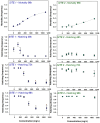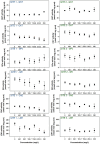Cyanobacterial Blooms in City Parks: A Case Study Using Zebrafish Embryos for Toxicity Characterization
- PMID: 39458312
- PMCID: PMC11509529
- DOI: 10.3390/microorganisms12102003
Cyanobacterial Blooms in City Parks: A Case Study Using Zebrafish Embryos for Toxicity Characterization
Abstract
Cyanobacteria are photosynthetic prokaryotes that play an important role in the ecology of aquatic ecosystems. However, they can also produce toxins with negative effects on aquatic organisms, wildlife, livestock, domestic animals, and humans. With the increasing global temperatures, urban parks, renowned for their multifaceted contributions to society, have been largely affected by blooms of toxic cyanobacteria. In this work, the toxicity of two different stages of development of a cyanobacterial bloom from a city park was assessed, evaluating mortality, hatching, development, locomotion (total distance, slow and rapid movements, and path angles) and biochemical parameters (oxidative stress, neurological damage, and tissue damage indicators) in zebrafish embryos/larvae (Danio rerio). Results showed significant effects for the samples with more time of evolution at the developmental level (early hatching for low concentrations (144.90 mg/L), delayed hatching for high concentrations (significant values above 325.90 mg/L), and delayed development at all concentrations), behavioral level (hypoactivity), and biochemical level (cholinesterase (ChE)) activity reduction and interference with the oxidative stress system for both stages of evolution). This work highlights the toxic potential of cyanobacterial blooms in urban environments. In a climate change context where a higher frequency of cyanobacterial proliferation is expected, this topic should be properly addressed by competent entities to avoid deleterious effects on the biodiversity of urban parks and poisoning events of wildlife, pets and people.
Keywords: bloom evolution; cyanotoxins; developmental delay; mortality; oxidative stress.
Conflict of interest statement
The authors declare no conflicts of interest.
Figures








Similar articles
-
Effects of triclosan on zebrafish early-life stages and adults.Environ Sci Pollut Res Int. 2009 Sep;16(6):679-88. doi: 10.1007/s11356-009-0119-3. Epub 2009 Mar 13. Environ Sci Pollut Res Int. 2009. PMID: 19283420
-
Microbial diversity, genomics, and phage-host interactions of cyanobacterial harmful algal blooms.mSystems. 2024 Jul 23;9(7):e0070923. doi: 10.1128/msystems.00709-23. Epub 2024 Jun 10. mSystems. 2024. PMID: 38856205 Free PMC article.
-
Multibiomarker-based assessment of toxicity of central European strains of filamentous cyanobacteria Aphanizomenon gracile and Raphidiopsis raciborskii to zebrafish Danio rerio.Water Res. 2021 Apr 15;194:116923. doi: 10.1016/j.watres.2021.116923. Epub 2021 Feb 11. Water Res. 2021. PMID: 33631698
-
Bloom Dynamics of Cyanobacteria and Their Toxins: Environmental Health Impacts and Mitigation Strategies.Front Microbiol. 2015 Nov 17;6:1254. doi: 10.3389/fmicb.2015.01254. eCollection 2015. Front Microbiol. 2015. PMID: 26635737 Free PMC article. Review.
-
Cyanobacterial blooms in China: diversity, distribution, and cyanotoxins.Harmful Algae. 2021 Nov;109:102106. doi: 10.1016/j.hal.2021.102106. Epub 2021 Sep 23. Harmful Algae. 2021. PMID: 34815019 Review.
References
Grants and funding
LinkOut - more resources
Full Text Sources

